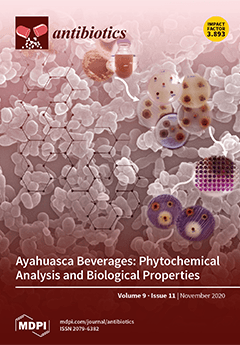Bacterial resistance has become a worrying problem for human health, especially since certain bacterial strains of
Escherichia coli (
E. coli) can cause very serious infections. Thus, the search for novel natural inhibitors with new bacterial targets would be crucial to overcome
[...] Read more.
Bacterial resistance has become a worrying problem for human health, especially since certain bacterial strains of
Escherichia coli (
E. coli) can cause very serious infections. Thus, the search for novel natural inhibitors with new bacterial targets would be crucial to overcome resistance to antibiotics. Here, we evaluate the inhibitory effects of
Apis mellifera bee venom (BV-
Am) and of its two main components -melittin and phospholipase A
2 (PLA
2)- on
E. coli F
1F
0-ATPase enzyme, a crucial molecular target for the survival of these bacteria. Thus, we optimized a spectrophotometric method to evaluate the enzymatic activity by quantifying the released phosphate from ATP hydrolysis catalyzed by
E. coli F
1F
0-ATPase. The protocol developed for inhibition assays of this enzyme was validated by two reference inhibitors, thymoquinone (IC
50 = 57.5 μM) and quercetin (IC
50 = 30 μM). Results showed that BV-
Am has a dose-dependent inhibitory effect on
E. coli F
1F
0-ATPase with 50% inhibition at 18.43 ± 0.92 μg/mL. Melittin inhibits this enzyme with IC
50 = 9.03 ± 0.27 µM, emphasizing a more inhibitory effect than the two previous reference inhibitors adopted. Likewise, PLA
2 inhibits
E. coli F
1F
0-ATPase with a dose-dependent effect (50% inhibition at 2.11 ± 0.11 μg/mL) and its combination with melittin enhanced the inhibition extent of this enzyme. Crude venom and mainly melittin and PLA
2, inhibit
E. coli F
1F
0-ATPase and could be considered as important candidates for combating resistant bacteria.
Full article


